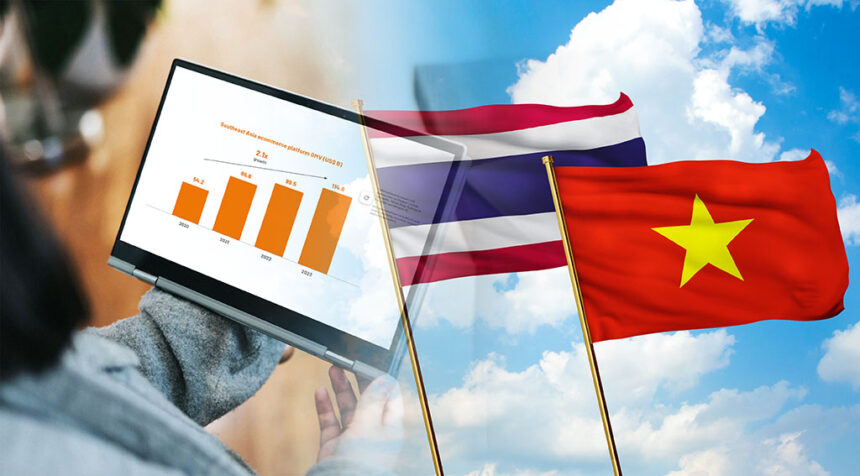In 2023, e-commerce will continue to expand in Southeast Asia, with gross merchandise volume (GMV) across the region’s top eight e-commerce platforms reaching US$114.6 billion, up 15% year-on-year. according to According to MomentumWorks’ “E-commerce in Southeast Asia 2024” report, this figure marks a 2.1-fold increase from 2020, indicating the rapid growth of e-commerce in the region.

E-commerce growth in Southeast Asia last year varied by country and platform. Vietnam and Thailand saw the strongest growth in the region, with GMV increasing 52.9% and 34.1% respectively year-on-year.
The surge made Vietnam the third-largest e-commerce nation in Southeast Asia with total trade volume of US$13.8 billion, overtaking the Philippines, which saw a much slower growth rate of 19.4 percent to US$13.7 billion.
Thailand maintains its position as the second-largest e-commerce market in Southeast Asia, with GMV expected to grow from US$14.4b in 2022 to US$19.3b in 2023. Indonesia maintained its position as the regional leader with a more modest 3.7% increase year-on-year to US$53.8b in GMV.
Indonesia will account for 46.9% of the region’s total GMV in 2023, down from 54% in 2022. This marks slower growth for Indonesia compared to other markets in Southeast Asia, which recorded double-digit growth last year.

Leading e-commerce platform in Southeast Asia
Shopee, a subsidiary of Singaporean tech conglomerate Sea, continued to dominate Southeast Asia’s e-commerce market with a 48% market share in 2023. The platform’s GMV grew from $47.9 billion in 2022 to $55.1 billion last year.
More notably, TikTok Shop, the video hosting service’s e-commerce feature, saw the strongest growth: In 2023, TikTok Shop’s GMV nearly quadrupled, putting it on par with Alibaba Group’s Lazada and Indonesian e-commerce giant Indonesia.
TikTok Shop is an e-commerce feature integrated within the TikTok app that allows users to browse and purchase products directly through the platform.
Features First released It entered the Indonesian market in February 2021, before expanding to Malaysia, Thailand, Vietnam and the Philippines in April 2022, and Singapore two months later. TikTok Shop launched in the US in September 2023 and is expanding across Europe. this year. company Claim There are 15 million merchants using this feature.

The rise of live commerce
The Momentum Works report also covers emerging trends in the Southeast Asian e-commerce market, highlighting the rise of live commerce. Live commerce, also known as live streaming commerce or live shopping, combines online shopping with live video streaming. This approach allows retailers and brands to showcase their products in real time through live broadcasts, allowing viewers to purchase the products directly from the live stream.
In Vietnam, brands such as Guno have seen rapid growth by leveraging TikTok’s livestreaming feature: The fashion brand attracted more than 3,000 viewers during a single livestream and sold VND2 billion ($79.3 million) worth of goods, said founder Nguyen Huong. Said She founded VNExpress in June, and after a year of live streaming on TikTok, the company’s monthly revenue has increased 20-fold, she said.
Top streamers in Vietnam can earn VND200-300 million ($8,000-12,000) in commissions per broadcast, according to Pham Ngoc Duy Liem, co-founder of streaming service provider GoStream.
In Thailand, live commerce accounted for 10% of alternative e-commerce in 2022, the highest proportion in all of Southeast Asia. according to This growth rate outpaces the region’s average growth rate of 8%, according to a 2022 report by Mehta and Bain & Company.

Suchaya Parewong, Marketing Director of Shopee Thailand, said: Said The Bangkok Post reported in March 2024 that Shopee’s live feature will enable sellers to triple their audience size, predicting 10x year-on-year sales growth in 2023.
According to the survey, Shopee will be the largest live commerce platform in 2022 with a market share of 27%. carried out According to Ninja Van Group, Shopee is followed by Facebook (25.5%), TikTok (22.5%), Lazada (15%), Instagram (7%) and YouTube (3%).

Southeast Asian e-commerce leaders embrace AI
Another e-commerce trend outlined in the Momentum Works report is the increasing use of artificial intelligence (AI), with leading platforms in the region such as Shopee, Lazada and Zalora embracing AI to provide customised offers and improve customer experience.
For example, Lazada Introduced In 2019, we introduced an AI-powered image-based search feature, allowing shoppers to find their desired products by taking or uploading an image, streamlining the product discovery process. Other AI applications powered by ChatGPT have followed suit. Rajee Chatis an AI chatbot that acts as a personal shopper by answering users’ questions and providing customized suggestions and product recommendations. It also has a skin testing feature that allows beauty enthusiasts to use their phone’s camera to perform a skin diagnosis and analysis and receive suitable product recommendations based on the results.
Meanwhile, Singapore’s Shopee is giving small and medium-sized businesses selling on its platform access to a range of AI-powered tools to help cross-border sellers overcome language barriers in new markets and make it easier to build an online presence.
This involves collecting data about shoppers’ purchasing patterns and using it to push relevant products. AI-powered chatbots “drive millions of conversations on Shopee every day and are especially useful during high-traffic events such as midnight sales,” a company spokesperson said. Said It is scheduled to air on Channel News Asia in May 2024.
In Indonesia, Tokopedia is using AI to understand user behavior and improve the experience of using the platform. The company has a 100% digitally-based customer service center called Tokopedia Care, where buyers and sellers can get solutions to their queries without the help of a human customer service team.
Featured Image Credit: Free Pick








